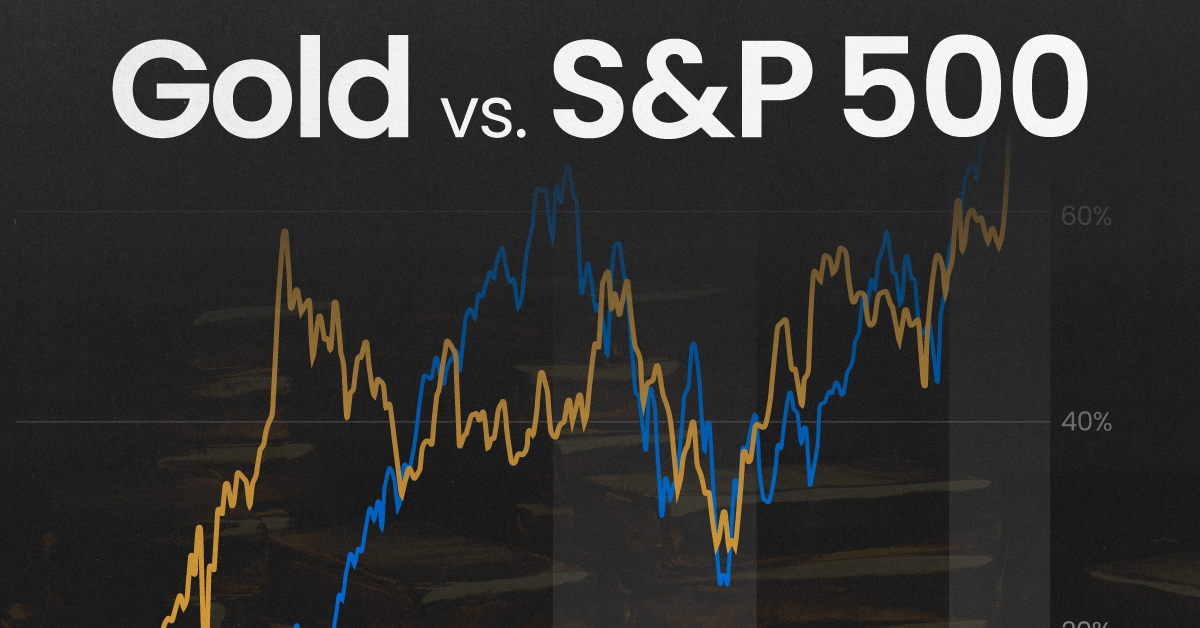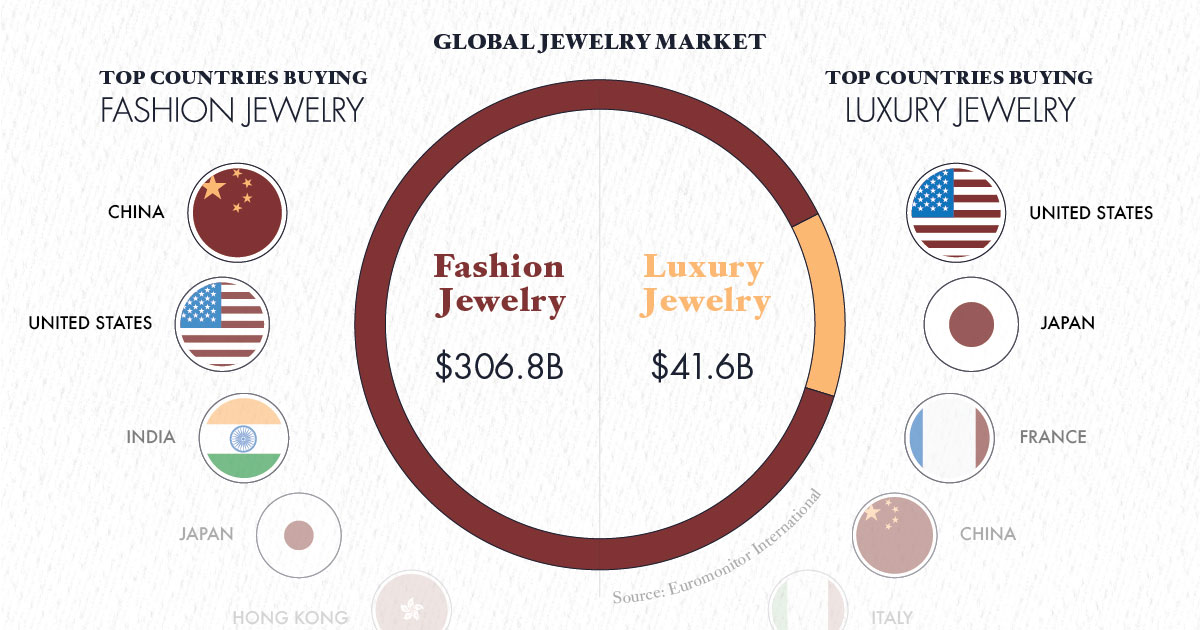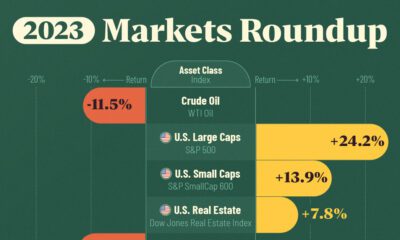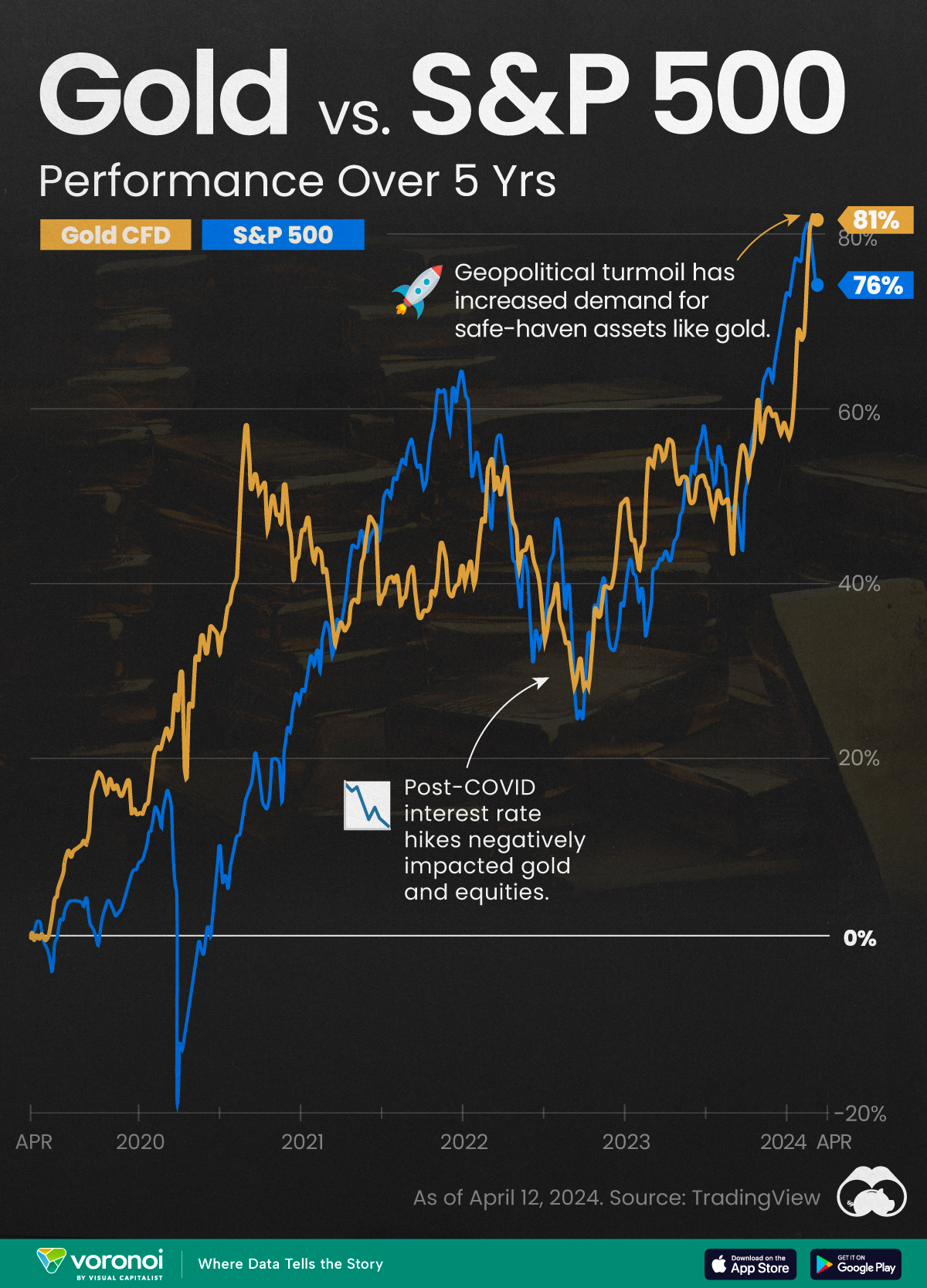Gold
A Brief History of Jewelry Through the Ages

Jewelry has been an integral aspect of human civilization for centuries, but it was the discovery and subsequent spread of precious metals and gemstones which really changed the game.
In today’s infographic from Menē, we visualize how the uses and symbolism of jewelry have evolved across time and space to become the industry we’re familiar with today.
Antique, Yet Ageless
There isn’t a single corner of the world that’s untouched by the influence of jewelry.
- Ancient Egypt
Gold accompanied the affluent into the afterlife – the famous 1922 discovery of King Tutankhamun’s tomb was filled to the brim with gold jewelry. - Ancient Greece and Rome
Jewelry was used practically, and as a protection against evil. The gold olive wreath design was highly popular during this time. - Mesopotamia
Both men and women in the Sumer civilization wore intricate pieces of jewelry, incorporating bright gems like agate, jasper, or lapis lazuli. - Meso-America
The aristocracy in Aztec culture wore gold jewelry with gemstones to demonstrate their rank. The jewelry also doubled up as godly sacrifices. - Ancient India
The Mughal Empire introduced the combination of gemstones with gold and silver. Today, pure gold jewelry is often gifted to new brides for financial security. - Ancient China
Both rich and poor wore jade jewelry for its durable and protective properties. Pure gold jewelry is making a fashion comeback, doubling as a form of investment.
Modern Jewelry: At a Crossroads
Today, jewelry is at once the very same and vastly different from what it used to be.
The industry is worth upwards of $348 billion per year, and it’s not hard to see why. As an alternative asset, jewelry has grown 138% in value over the last decade – only outperformed by classic cars, rare coins, and fine wine.
However, perceptions of jewelry vastly differ. It’s not a stretch to say that Western jewelry buyers are enamored with diamonds, given their enduring association with special occasions – but it’s interesting to note how that ideal was fabricated.
The Invention of Diamonds
The De Beers Group is well known for making diamonds great again. In the early 1900s, the company had already monopolized the diamond trade and stabilized the market, but they faced the challenge of marketing diamonds to consumers at all income levels.
The average American considered diamonds an extravagance, preferring to spend money on cars and appliances instead. The concept of engagement rings existed, but weren’t widely adopted. The #1 slogan of the century – “A Diamond is Forever” – transformed all that.
Even as more companies like Tiffany and Co and Cartier entered the playing field, De Beers had set a successful industry standard. But there’s a catch – diamonds are actually:
- Not all that rare in nature
- Intrinsically low in value
- Easily replicated in a lab
- Decreasing in sales
Despite these caveats, the popularity of diamonds illustrate how Western consumers do not approach jewelry in the same way as Eastern economies, where its function as a store of wealth persists.
The Eastern Gold Standard
In Eastern economies, jewelry often takes the form of pure gold. The reasons behind this difference are surprisingly pragmatic: gold is considered a secure and innate store of wealth that maintains its purchasing value over decades, allowing families to pass wealth from generation to generation.
The rich history of the precious metal has made it a sought-after commodity for centuries, and China and India drive more than half of global gold jewelry demand every year:
| Year | Share of Demand (India + China) | Total Global Jewelry Demand (tonnes) |
|---|---|---|
| 2014 | 57% | 2510 tonnes |
| 2015 | 58% | 2426 tonnes |
| 2016 | 55% | 2068 tonnes |
| 2017 | 57% | 2201 tonnes |
| 2018 | 58% | 2200 tonnes |
Source: Gold Hub – Values have been rounded up to the nearest tonne.
Why are Eastern cultures so attracted to the properties of pure gold?
Part 2 of this series will show why gold is the world’s most incredible metal, and why it’s coveted by billions of people.
Mining
Gold vs. S&P 500: Which Has Grown More Over Five Years?
The price of gold has set record highs in 2024, but how has this precious metal performed relative to the S&P 500?

Gold vs. S&P 500: Which Has Grown More Over Five Years?
This was originally posted on our Voronoi app. Download the app for free on Apple or Android and discover incredible data-driven charts from a variety of trusted sources.
Gold is considered a unique asset due to its enduring value, historical significance, and application in various technologies like computers, spacecraft, and communications equipment.
Commonly regarded as a “safe haven asset”, gold is something investors typically buy to protect themselves during periods of global uncertainty and economic decline.
It is for this reason that gold has performed rather strongly in recent years, and especially in 2024. Persistent inflation combined with multiple wars has driven up demand for gold, helping it set a new all-time high of over $2,400 per ounce.
To put this into perspective, we visualized the performance of gold alongside the S&P 500. See the table below for performance figures as of April 12, 2024.
| Asset/Index | 1 Yr (%) | 5 Yr (%) |
|---|---|---|
| 🏆 Gold | +16.35 | +81.65 |
| 💼 S&P 500 | +25.21 | +76.22 |
Over the five-year period, gold has climbed an impressive 81.65%, outpacing even the S&P 500.
Get Your Gold at Costco
Perhaps a sign of how high the demand for gold is becoming, wholesale giant Costco is reportedly selling up to $200 million worth of gold bars every month in the United States. The year prior, sales only amounted to $100 million per quarter.
Consumers aren’t the only ones buying gold, either. Central banks around the world have been accumulating gold in very large quantities, likely as a hedge against inflation.
According to the World Gold Council, these institutions bought 1,136 metric tons in 2022, marking the highest level since 1950. Figures for 2023 came in at 1,037 metric tons.
See More Graphics on Gold
If you’re fascinated by gold, be sure to check out more Visual Capitalist content including 200 Years of Global Gold Production, by Country or Ranked: The Largest Gold Reserves by Country.
-

 Green2 weeks ago
Green2 weeks agoRanked: Top Countries by Total Forest Loss Since 2001
-

 Travel1 week ago
Travel1 week agoRanked: The World’s Top Flight Routes, by Revenue
-

 Technology1 week ago
Technology1 week agoRanked: Semiconductor Companies by Industry Revenue Share
-

 Money2 weeks ago
Money2 weeks agoWhich States Have the Highest Minimum Wage in America?
-

 Real Estate2 weeks ago
Real Estate2 weeks agoRanked: The Most Valuable Housing Markets in America
-

 Markets2 weeks ago
Markets2 weeks agoCharted: Big Four Market Share by S&P 500 Audits
-

 AI2 weeks ago
AI2 weeks agoThe Stock Performance of U.S. Chipmakers So Far in 2024
-

 Automotive2 weeks ago
Automotive2 weeks agoAlmost Every EV Stock is Down After Q1 2024














